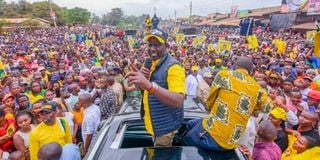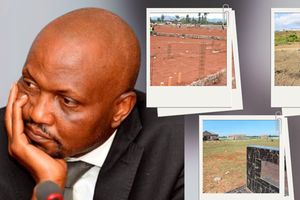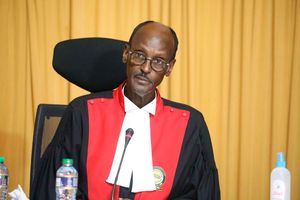Premium
Kenya Kwanza sits prettier ahead of polls as Azimio’s fortresses crumble

Deputy President William Ruto addresses a Kenya Kwanza campaign rally at Ishiara Market, Embu County.
What you need to know:
- Dr Ruto’s style at the manifesto launch was the display of a man who understands Kenya.
- In comparison, the presentation of the Azimio manifesto was a drooling session.
Five weeks to the general election, it is not difficult to discern how the stars are aligned for the August 9 presidential poll. The two foremost candidates – Deputy President William Ruto and former Prime Minister Raila Odinga – have since presented their manifestos, and the electoral campaign is set for the final dash to the finish.
Dr Ruto’s manifesto focused on the many concrete issues that have held Kenya and Kenyans back. They include the despair of the man and woman at the bottom of the country’s economic pyramid, high unemployment, poor agricultural productivity, a toxic business environment, unaffordable healthcare and the poor state of governance.
The plan resonated with the majority of Kenyans, if the conversations during and after Thursday’s launch are anything to go by. Dr Ruto’s style at the manifesto launch was the display of a man who understands Kenya, what has failed, how to rectify it and the path to transformation. The collegial part played by his colleagues in Kenya Kwanza Alliance communicated a team that understood the issues and worked in sync.
In comparison, the presentation of the Azimio manifesto was a drooling session. The monologue rose and fell on the mitumba (second-hand clothes) insult that the business dwells on products of the dead. An attempt to rewind the clock on the matter did not wash. Azimio’s foremost posterboy, former United Nations Conference on Trade and Development Secretary-General Mukhisa Kituyi, rubbed it in with “we love mitumba traders, but we hate mitumba” jibe.
A media interview for Mr Odinga and his running mate on Tuesday, two days before Kenya Kwanza’s manifesto presentation, was an attempt to rehash their policy statement. The effort fell flat on its face and there has been no evidence that the outing gave their agenda any impetus.
Political somersaults
Three years ago, Dr Ruto pledged to change the conversation from the usual political mumbo jumbo and make the next election about economic issues. This has come true, but his competitors have shown, in word and deed, that they were not prepared for the enormous length and breadth of this endeavour.
No wonder they wasted four years propagating unhelpful constitutional changes under the Building Bridges Initiative (BBI). The endeavour came crashing down this year with a Return-to-sender stamp from three superior courts.
The political campaign has also established a pattern that points to the strengths – or otherwise – of the two premier candidates. From 2018, President Uhuru Kenyatta and Mr Odinga were keen to have all the political heavyweights on one side and isolate Dr Ruto. BBI was to be the silver bullet in this political game. It was not lost on the handshake partners that Dr Ruto would cruise to easy victory if the opposition leaders stayed together or ran separately.
The plan flopped when Amani National Congress leader Musalia Mudavadi and Ford-Kenya’s Moses Wetang’ula spurned the political backstabbing, opaqueness and the divisiveness that has underwritten the whole project since day one. They joined Dr Ruto to push the agenda of economic inclusion and justice for all.
Governors Alfred Mutua and Amason Kingi, too, have joined the juggernaut that the Kenya Kwanza Alliance has become. So, too, has National Assembly Speaker JB Muturi.
Though Wiper’s Kalonzo Musyoka eventually ended up in Azimio, his numerous political somersaults, failure to land the running mate slot and the bridges he burnt over Mr Odinga might have gone too far in his stronghold to be undone by August 9.
Odinga’s Achilles heel
It is, therefore, evident in Western and Coast regions, two bastions that gave Mr Odinga massive backing in 2007, 2013 and 2017, that the support has dipped as a result. In fact, the Azimio campaign in the regions is crawling. In Western, lack of a tangible agenda and perceived shabby treatment of political leaders from the region, especially Mr Mudavadi and Mr Wetang’ula, has wounded Azimio irreparably.
At the Coast, the Mombasa Port is Mr Odinga’s Achilles heel. The operations at that premier asset have been massively disrupted after the setting up of inland container depots (ICD) in Nairobi and at Suswa in Narok. The official talk that the ICD is in Naivasha is untrue and diversionary for reasons that are not difficult to fathom.
The Kenya Railways’ website clearly states that the ICD is 15km from Maai Mahiu town, off the Maai Mahiu-Narok-Kaplong road! Basic geography disputes that this is the direction to Naivasha.
Mr Odinga and his allies were vile critics of the ICD plan in the run-up to the 2017 election. But the handshake greased off the opposition and they are said to have become beneficiaries of what was essentially anathema to them five years ago. The economy of Mombasa and the Coast has been affected. On this, Mr Odinga cannot run away from charges of betrayal.
Azimio’s bad week in North-Eastern adds to the enormity of the camp’s haemorrhage.
As for Mt Kenya, the less said the better.
Mr Buku works in the William Ruto presidential campaign; [email protected]





